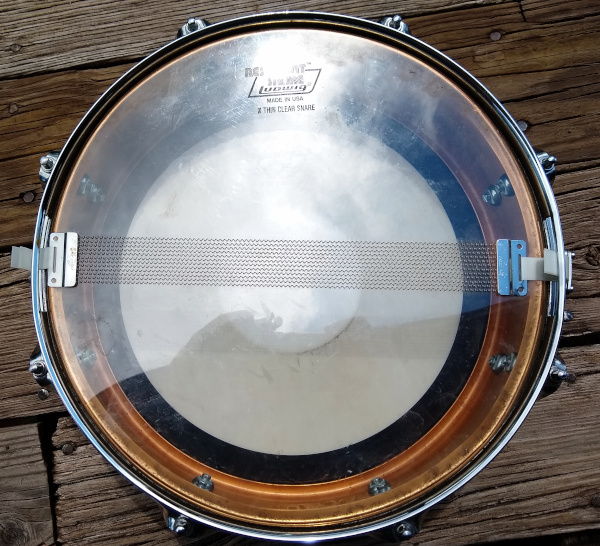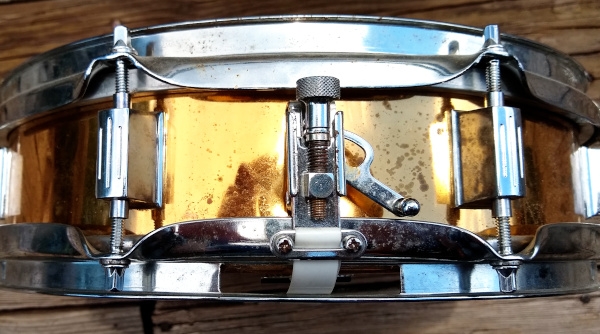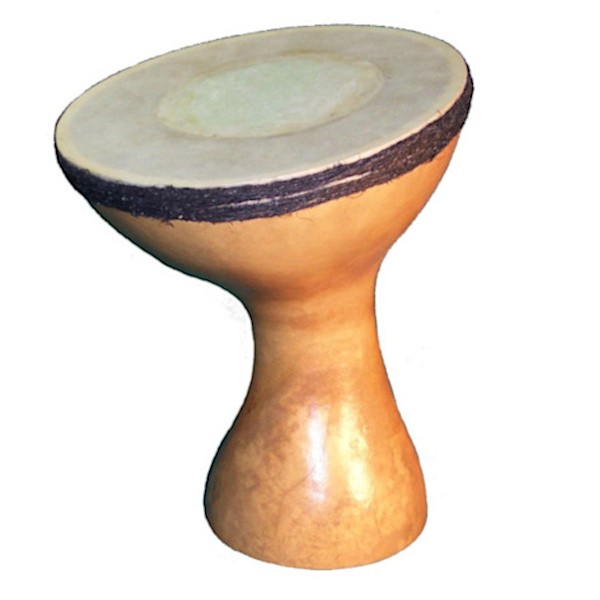The Gourd Snare is one possible answer to the question, what kind of modifications can be made to a drum’s membrane such that it still produces an interesting sound? And if one were to attempt to assemble a drum kit made from gourds, a gourd snare would be requisite.
The gourd snare shown in the featured image above doesn’t use the same mechanism as a typical snare drum. Snare drums usually have two heads and a taut metal chain (snare) stretched across the bottom (snare) head (Figure 1). The snare is attached to the side of the drum with a snare strainer (Figure 2). The two main components of the strainer for tensioning the snare in most snare drums are the snare adjustment screw and the throw lever (or throwoff).1 The snare adjustment screw (top of snare strainer strainer mechanism in Figure 2), is a fine adjustment screw that tightens or loosens the snares across the bottom membrane. Most people keep their snare pretty tight, but it is possible to modulate things like decay (the rate at which a sound fades to silence2) a bit by adjusting the fine adjustment screw. The throw lever (visible on the right hand side of the snare strainer in Figure 2) is the mechanism that engages or disengages the snares on the snare head. When the throw lever is disengaged, the snare makes no contact with the lower head and the drum functions as a tom-tom. When the throw lever is engaged, the snare makes contact with the bottom membrane. When the player strikes the top head, the pressure wave passes through the air mass inside the shell to the bottom head, which vibrates the snare, producing the drum’s unique sound.
Having a snare butt against the side of the membrane is a way of capitalizing on the vibrational energy3 of the membrane to produce a rattling sound. In a membraneophone, this effect is cumulative. A snare could be removed from a snare drum and played independently by shaking it, scratching it, or hitting it with a stick (etc). Similarly, the snare drum’s membrane produces the sound of a tom-tom in the absence of the snare. It is the union of these effects that make the sound produced interesting.


Is it possible to modify the membrane of a gourd drum in other ways? One of the (major) issues encountered when modifying a drum’s membrane is the damping effect that any modifications to its surface has on its vibrational movement. Damping is a decrease in the amplitude of an oscillation as a result of energy being drained from the system to overcome frictional or other resistive forces.4 While adding a snare to any membrane creates some damping, it is certainly a less destructive method of modifying the membrane then by doing something like cutting a bunch of holes in it. The basic mechanics of snare drum are a great way to begin to entertain some of the these possibilities.
To design our Gourd Snare, we integrated the sound generator directly into a double–layer head. This is done by sandwiching BBs (as in the kind used for a BB gun) between a smaller inner and a larger outer head. The inner head is mounted so that it’s underneath the larger drumhead (facing inside the drum shell) in Figure 3. This non-traditional approach has its limitations (quite a bit of damping is observed), but the the overall effect definitively captures the sound that makes a snare drum unique. The great part about incorporating the snare directly into the head is that a complete build of a gourd snare can be accomplished over a couple of sessions in a workshop.

A gourd snare built using modern snare drum techniques is certainly feasible, but would require a double headed drum (see Double Membrane Drum or Traditional Talking Drum) and, of course, some sort of snare mechanism. A more traditional snare could be something as simple as scavenging a junk yard for small springs or other interesting obtainium and lashing it to the bottom head. There are also many places online (and probably locally too!) that sell commercial snare chains and snare strainers. Affixing a snare strainer to the profile of a gourd could be a bit tricky and would most assuredly require some sort of reinforcement, but is definitely doable.
References:
- Wikipedia contributors. “Drum Hardware.” Wikipedia: The Free Encyclopedia. 17 February 2021. https://en.wikipedia.org/wiki/Drum_hardware. Accessed 3 July 2021.
- Britannica, The Editors of Encyclopaedia. “Envelope – Sound”. Encyclopedia Britannica. https://en.wikipedia.org/wiki/Drum_hardware. Accessed 3 July 2021.
- Wikipedia contributors. “Vibrations of a circular membrane”. Wikipedia: The Free Encyclopedia. 23 April 2021. https://en.wikipedia.org/wiki/Vibrations_of_a_circular_membrane. Accessed 3 July 2021.
- Britannica, The Editors of Encyclopaedia. “Damping – Physics”. Encyclopedia Britannica. https://www.britannica.com/science/damping. Accessed 3 July 2021.
